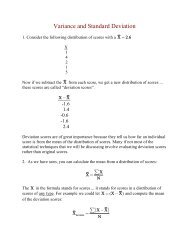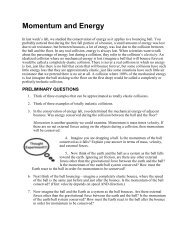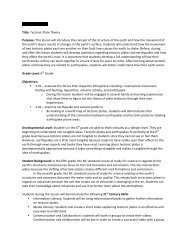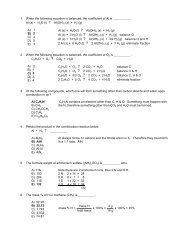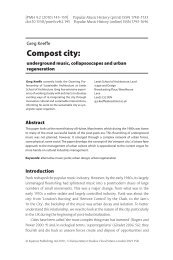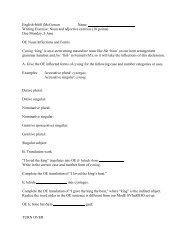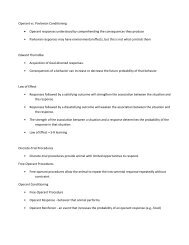1. Which response lists all the following pairs of liquids that are ...
1. Which response lists all the following pairs of liquids that are ...
1. Which response lists all the following pairs of liquids that are ...
Create successful ePaper yourself
Turn your PDF publications into a flip-book with our unique Google optimized e-Paper software.
<strong>1.</strong> <strong>Which</strong> <strong>response</strong> <strong>lists</strong> <strong>all</strong> <strong>the</strong> <strong>following</strong> <strong>pairs</strong> <strong>of</strong> <strong>liquids</strong> <strong>that</strong> <strong>are</strong> mutu<strong>all</strong>y soluble.<br />
Pair # <strong>1.</strong> octane (C 8 H 18 ) and water.<br />
Pair # 2. acetic acid (CH 3 COOH) and water.<br />
Pair # 3. octane (C 8 H 18 ) and benzene (C 6 H 6 ).<br />
One is polar, <strong>the</strong> o<strong>the</strong>r non-polar.<br />
Both <strong>are</strong> polar and capable <strong>of</strong> hydrogen bonding<br />
Both <strong>are</strong> not polar with only dispersion forces<br />
A. 1, 3<br />
B. 1, 2<br />
C. 3<br />
D. 2, 3<br />
E. 2<br />
2. <strong>Which</strong> <strong>of</strong> <strong>the</strong> <strong>following</strong> <strong>liquids</strong> would make a good solvent for iodine, I 2 ?<br />
A. HCl<br />
B. H 2 O<br />
C. CH 3 OH<br />
D. NH 3<br />
E. C 6 H 14 This is not polar (dispersion forces only) like I 2 . The o<strong>the</strong>rs <strong>are</strong> <strong>all</strong> polar.<br />
3. What is <strong>the</strong> molarity <strong>of</strong> a 17.0% solution <strong>of</strong> sodium acetate, CH 3 COONa (0 = 82.0 g/mol) in water? Given <strong>the</strong> density is <strong>1.</strong>09<br />
g/mL.<br />
17% indicates 17 g sodium acetate (NaOAc) in 100 g solution (17g NaOAc and 83 g H 2 O)<br />
A. 2.26 x 10 -2 M<br />
1 mol.<br />
1 mL 1 L<br />
B. 0.207 M mol. NaOAc = 17 g x = 0.207 mol. L sol. = 100 g x x = 0.0917 L<br />
C. 2.07 M<br />
18 g<br />
<strong>1.</strong>09 g 1000 mL<br />
D. 2.26 M<br />
0.207 mol.<br />
E. 2.72 M M = = 2.26<br />
0.0917 L<br />
4. What is <strong>the</strong> percent CdSO 4 (0 = 208.5 g/mol) by mass in a <strong>1.</strong>0 molal aqueous solution?<br />
A. 0.001 %<br />
B. 0.10 %<br />
C. 17.2 %<br />
D. 20.8 %<br />
E. 24.4 %<br />
<strong>1.</strong>0 m indicates <strong>that</strong> <strong>1.</strong>0 mol. CdSO 4 is dissolved in 1 kg (1000 g) water.<br />
With a molecular mass <strong>of</strong> 208.5 g/mol. indicates <strong>that</strong> <strong>that</strong> <strong>1.</strong>0 mol. equals 208.5 g<br />
g CdSO4<br />
208.5 g CdSO4<br />
% mass = x 100% =<br />
x 100% = 17.2 %<br />
g total<br />
208.5 g CdSO + 1000 g H O<br />
4<br />
2<br />
5. Calculate <strong>the</strong> percent by mass <strong>of</strong> potassium nitrate in a solution made from 45.0 g KNO 3 and 295 mL <strong>of</strong> water. Density <strong>of</strong><br />
water is <strong>1.</strong>00 g/mL.<br />
A. <strong>1.</strong>51%<br />
B. 7.57%<br />
C. 13.3%<br />
D. 15.2%<br />
E. none <strong>of</strong> <strong>the</strong>m<br />
g KNO3<br />
45.0 g KNO3<br />
% mass = x 100% =<br />
x 100% = 13.2 %<br />
g total<br />
45.0 g KNO + 295 g H O<br />
3<br />
2<br />
6. How many grams <strong>of</strong> water <strong>are</strong> needed to dissolve 27.8 g <strong>of</strong> ammonium nitrate (0 = 80.05 g/mol) in order to prep<strong>are</strong> a<br />
0.452 m solution?<br />
A. 0.157 g<br />
B. 36.2 g<br />
C. 100 g<br />
D. 769 g<br />
E. 157 g<br />
1 mol.<br />
mol. NH<br />
=<br />
80.05 g<br />
4NO3<br />
= 27.8 g x 0.247 mol. NH 4NO3<br />
0.247 mol. NH 4NO3<br />
0.452 m = ⇒ x = 0.769 g H 2O<br />
= 769 g H 2O<br />
x kg H O<br />
2
7. Calculate <strong>the</strong> molality <strong>of</strong> a solution containing 14.3 g <strong>of</strong> NaCl (0 = 58.4 g/mol) in 42.2 g <strong>of</strong> water.<br />
A. 2.45 x 10 4 m<br />
B. 5.80 x 10 4 m<br />
C. 24.5 m<br />
D. 5.79 m<br />
E. 103 m<br />
1 mol.<br />
mol. NaCl = 14.3g x = 0.245 mol. NaCl<br />
58.4 g<br />
mol. NaCl 0.245 mol. NaCl<br />
m = =<br />
= 5.79 m<br />
kg H O 0.0422 kg H O<br />
2<br />
2<br />
8. The solubility <strong>of</strong> CO 2 gas in water<br />
A. increases with increasing temperature.<br />
B. decreases with increasing temperature.<br />
C. is not dependent on temperature.<br />
9. The solubility <strong>of</strong> CO 2 gas in water<br />
A. increases with increasing gas pressure. Rec<strong>all</strong> Henry’s Law: c = k· P (where c is solubility and P is <strong>the</strong> pressure)<br />
B. decreases with increasing gas pressure.<br />
C. is not dependent on pressure.<br />
10. <strong>Which</strong> <strong>of</strong> <strong>the</strong> <strong>following</strong> statements <strong>are</strong> false?<br />
A. The vapor pressure <strong>of</strong> a solvent over a solution decreases as its mole fraction increases.<br />
B. The solubility <strong>of</strong> a gas increases as <strong>the</strong> temperature decreases. See question 8.<br />
C. The vapor pressure <strong>of</strong> a solvent over a solution is less than <strong>that</strong> <strong>of</strong> pure solvent. See question 12.<br />
D. The greater <strong>the</strong> pressure <strong>of</strong> a gas over a solution <strong>the</strong> greater its solubility. See question 9.<br />
E. Ionic solutes dissociate in solution causing an enhancement <strong>of</strong> <strong>all</strong> colligative properties. See question 14.<br />
1<strong>1.</strong> Consider a solution made from a nonvolatile solute and a volatile solvent. <strong>Which</strong> statement is true?<br />
A. The vapor pressure <strong>of</strong> <strong>the</strong> solution is always greater than <strong>the</strong> vapor pressure <strong>of</strong> <strong>the</strong> pure solvent. See question 12<br />
B. The boiling point <strong>of</strong> <strong>the</strong> solution is always greater than <strong>the</strong> boiling point <strong>of</strong> <strong>the</strong> pure solvent. See question 14<br />
C. The freezing point <strong>of</strong> <strong>the</strong> solution is always greater than <strong>the</strong> freezing point <strong>of</strong> <strong>the</strong> pure solvent. See question 17<br />
D. The osmotic pressure <strong>of</strong> <strong>the</strong> solution is always less than <strong>the</strong> osmotic pressure <strong>of</strong> <strong>the</strong> pure solvent. See questions 15, 16<br />
12. The vapor pressure <strong>of</strong> water at 20°C is 17.5 mmHg. What is <strong>the</strong> vapor pressure <strong>of</strong> water over a solution prep<strong>are</strong>d from 0.584<br />
mol. <strong>of</strong> sucrose and 19.4 mol. water?<br />
A. 0.53 mmHg<br />
B. 5.81 mmHg<br />
C. 17.0 mmHg<br />
D. 18.0 mmHg<br />
E. 33.2 mmHg<br />
χ =<br />
mol. solventl<br />
mol. total<br />
19.4 mol. H 2O<br />
=<br />
= 0.971<br />
19.4 H O + 0.584 mol.sucrose<br />
P = χP° = (0.971)(17.5 mm Hg) = 17.0 mm Hg<br />
2<br />
13. Dissolving a solute such as KOH in a solvent such as water results in<br />
A. an increase in <strong>the</strong> melting point <strong>of</strong> <strong>the</strong> liquid.<br />
B. a decrease in <strong>the</strong> boiling point <strong>of</strong> <strong>the</strong> liquid.<br />
C. a decrease in <strong>the</strong> vapor pressure <strong>of</strong> <strong>the</strong> liquid. See question 12.<br />
D. no change in <strong>the</strong> boiling point <strong>of</strong> <strong>the</strong> liquid.<br />
14. <strong>Which</strong> <strong>of</strong> <strong>the</strong> <strong>following</strong> aqueous solutions has <strong>the</strong> highest boiling point? Given K b = 0.52°C/m<br />
A. 0.2 m KCl<br />
B. 0.2 m Na 2 SO 4<br />
C. 0.2 m Al(NO 3 ) 3<br />
D. pure water<br />
E. <strong>all</strong> <strong>are</strong> <strong>the</strong> same<br />
∆T b = i· K b· m Since <strong>the</strong> boiling point constant and molality <strong>are</strong> <strong>the</strong> same for A-C, <strong>the</strong> determining<br />
factor is i, which is 2 for A, 3 for B and 4 for C. Rec<strong>all</strong> <strong>that</strong> I gives <strong>the</strong> number <strong>of</strong> dissolved<br />
species, and <strong>that</strong> <strong>the</strong> ionic compounds <strong>all</strong> dissociate.
15. <strong>Which</strong> <strong>of</strong> <strong>the</strong> <strong>following</strong> solutions has <strong>the</strong> highest osmotic pressure at 25°C?<br />
A. 0.2 M LiBr<br />
B. 0.2 M ethanol<br />
C. 0.2 M Na 2 SO 4<br />
D. 0.2 M KCl<br />
Π = i· MRT Since M, R and T <strong>are</strong> <strong>the</strong> same for <strong>all</strong> solutions, <strong>the</strong> determining factor must be i,<br />
which gives <strong>the</strong> number <strong>of</strong> dissolved species in solution. i = 3 for Na 2 SO 4 (2 Na + and 1 SO 2- 4 ).<br />
16. During osmosis<br />
A. pure solvent diffuses through a membrane but solutes do not.<br />
B. pure solutes diffuse through a membrane but solvent does not.<br />
C. pure solvent and a solution both diffuse at <strong>the</strong> same time through a membrane.<br />
D. gases diffuse through a membrane into a solution and build up pressure.<br />
17. Calculate <strong>the</strong> freezing point <strong>of</strong> a solution made from 22.0 g <strong>of</strong> octane (0 = 114.2 g/mol) dissolved in 148.0 g <strong>of</strong> benzene.<br />
Benzene freezes at 5.50°C and its K f value is 5.12°C/m.<br />
A. -<strong>1.</strong>16°C<br />
B. 0.98°C<br />
C. 6.66°C<br />
D. 12.2°C<br />
E. 5.49°C<br />
1mol.<br />
0.193 mol. octane<br />
22.0 g x = 0.193 mol. octane m =<br />
= <strong>1.</strong>30 m<br />
114.2 g<br />
0.148 kg<br />
∆T f = i· K f· m =(1)(5.12°C/m)(<strong>1.</strong>30 m) = 6.66°C<br />
T f = T f ° - ∆T f = 5.50°C – 6.66°C = -<strong>1.</strong>16°C<br />
18. Consider a 0.90 M Al(NO 3 ) 3 solution. This solution has a nitrate ion concentration <strong>of</strong><br />
A. 0.30 M<br />
B. 0.90 M<br />
C. 0.0 M<br />
D. 8.1 M<br />
E. 2.7 M<br />
Al(NO 3 ) 3 → Al 3+ (aq) + 3NO - 3 (aq)<br />
Thus 0.90 M Al(NO 3 ) 3 will dissociate, giving 3 times <strong>that</strong> concentration <strong>of</strong> NO - 3 .<br />
19. Alpha particles <strong>are</strong> identical to<br />
A. protons.<br />
B. helium atoms.<br />
C. hydrogen atoms.<br />
D. helium nuclei.<br />
E. electrons.<br />
Consider <strong>the</strong> nuclear symbols for electrons ( 4 4<br />
2 α ) and beta particles ( 2 He<br />
) and <strong>the</strong> fact <strong>that</strong> <strong>the</strong><br />
particle originates from <strong>the</strong> nucleus and is devoid <strong>of</strong> electrons.<br />
20. Beta particles <strong>are</strong> identical to<br />
A. protons.<br />
B. helium atoms.<br />
C. hydrogen atoms.<br />
D. helium nuclei.<br />
E. electrons.<br />
Consider <strong>the</strong> nuclear symbols for electrons ( - ) and beta particles ( <br />
e<br />
0 1<br />
- 0 1 )<br />
33<br />
2<strong>1.</strong> How many neutrons and protons (nucleons) does an atom with <strong>the</strong> symbol: 16 S<br />
A. 33<br />
B. 16<br />
C. 49<br />
D. 16<br />
E. none <strong>of</strong> <strong>the</strong>m<br />
33 is <strong>the</strong> mass number and is equal to <strong>the</strong> number <strong>of</strong> protons + neutrons.
22. A radioisotope decays to give an alpha particle and Pb-208. What was <strong>the</strong> original element?<br />
A. Se<br />
B. Bi<br />
C. Po<br />
D. Hg<br />
E. Rn<br />
A 4 208<br />
Z X → 2α<br />
+ 82<br />
Pb<br />
A = 4 + 208 = 212, Z = 82 + 2 = 84<br />
Thus:<br />
A<br />
X 212<br />
Z = 84<br />
Po<br />
23. When atoms <strong>of</strong> beryllium-9 <strong>are</strong> bombarded with alpha particles, neutrons <strong>are</strong> produced. What new isotope is also formed?<br />
4 9<br />
1<br />
He + Be → n X<br />
2 4<br />
0 +<br />
12<br />
A. 6 C<br />
5<br />
B. 3 Li<br />
8<br />
C. 3 Li<br />
10<br />
D. 5 B<br />
12<br />
E. 5 B<br />
4 9 1 A<br />
2 He + 4Be<br />
→ 0n<br />
+ Z<br />
A = 4 + 9 - 1 = 12, Z = 2 + 4 - 0 = 6<br />
Thus:<br />
A<br />
Z X =<br />
12 6<br />
C<br />
X<br />
24. When atoms <strong>of</strong> aluminum-27 <strong>are</strong> bombarded with alpha particles, neutrons <strong>are</strong> produced. What new isotope is also formed?<br />
4 27 1<br />
He + Al → n X<br />
2 13 0 +<br />
31<br />
A. 14 Si<br />
30<br />
B. 14 Si<br />
31<br />
C. 16 S<br />
30<br />
D. 15 P<br />
31<br />
E. 15 P<br />
4 27 1 A<br />
2 He + 13 Al → 0n<br />
+ Z<br />
A = 4 + 27 - 1 = 30, Z = 2 + 13 - 0 = 15<br />
Thus:<br />
A<br />
X 30<br />
Z = 15<br />
P<br />
X<br />
25. Sulfur-35 decays by beta emission. The decay product is:<br />
35<br />
A. 15 P<br />
36<br />
B. 16 S<br />
34<br />
C. 16 S<br />
34<br />
D. 17 Cl<br />
35<br />
E. 17 Cl<br />
35 0 A<br />
16 S → -1β<br />
+ Z<br />
X<br />
A = 35 - 0 = 35, Z = 16 - -1 = 17<br />
Thus:<br />
A<br />
Z = 17<br />
X 35 Cl<br />
232<br />
26. In <strong>the</strong> 90 Th decay series <strong>the</strong>re <strong>are</strong> six radioisotopes (including <strong>the</strong> Th-232 itself) <strong>that</strong> decay be alpha emission, and four <strong>that</strong><br />
decay by beta emission. What is <strong>the</strong> final (stable) isotope?<br />
204<br />
A. 74 W<br />
208<br />
B. 74 W<br />
204<br />
C. 82 Pb<br />
208<br />
D. 82 Pb<br />
208<br />
E. 78 Pt<br />
232<br />
4 0 A<br />
90 Th → 6 2α<br />
+ 4 -1β<br />
+ Z<br />
X<br />
A = 232 – 6(4) – 4(0) = 208, Z = 90 – 6(2) – 4(-1) = 82<br />
Thus:<br />
A<br />
Z X =<br />
208<br />
82<br />
Pb
27. Calculate <strong>the</strong> energy released in joules when one mole <strong>of</strong> Po-214 decays according to <strong>the</strong> equation<br />
214<br />
210 4<br />
Po → Pb He<br />
84 82 + 2<br />
Given <strong>the</strong> atomic masses: Pb-210 = 209.98284 amu, Po-214 = 213.99519 amu, and He-4 = 4.00260 amu.<br />
(c = 3.00 x 10 8 m/s, 1000 amu· m 2 /s 2 = 1 J/mol.)<br />
A. 8.78 x 10 14 J/mol.<br />
B. 7.2 x 10 14 J/mol.<br />
C. 8.78 x 10 11 J/mol.<br />
D. -9.75 x 10 -3 J/mol.<br />
E. <strong>1.</strong>46 x 10 -9 J/mol.<br />
∆m = 213.99519 – 209.98284 – 4.00260 = 0.00975 amu<br />
E = mc 2 = (0.00975 amu)(3.00 x 10 8 m/s) = 8.78 x 10 14 amu· m 2 /s 2<br />
E = 8.78 x 10 11 J/mol.<br />
28. What fraction <strong>of</strong> radioactive atoms remains in a sample after six half-lives?<br />
A. zero<br />
B. 1/6<br />
C. 1/16<br />
D. 1/32<br />
E. 1/64<br />
After one half-life, only ½ <strong>the</strong> original amount remains. After a second half-life, ½ <strong>of</strong> <strong>that</strong> is<br />
left (leaving ¼ <strong>of</strong> <strong>the</strong> original). After a third half-life, ½ <strong>of</strong> <strong>that</strong> is left (leaving C <strong>of</strong> <strong>the</strong><br />
original). Thus: (½)(½)(½)(½)(½)(½) = [ is left after 6 half-lives.<br />
29. Carbon-11 is a radioactive isotope <strong>of</strong> carbon. Its half-life is 20.3 minutes. What fraction <strong>of</strong> <strong>the</strong> initial number <strong>of</strong> C-11 atoms<br />
in a sample will remain after 81 minutes?<br />
A. 1/16<br />
B. 1/4<br />
C. 1/2<br />
D. 1/32<br />
E. 1/8<br />
81 minutes represents 4 half-lives.<br />
Thus: (½)(½)(½)(½) = L is left after 4 half-lives.<br />
30. The 14 C activity <strong>of</strong> some ancient Peruvian corn was found to be 10 disintegrations per minute per gram <strong>of</strong> carbon. If presentday<br />
plant life shows 15 dpm/g, how old is <strong>the</strong> Peruvian corn? The half-life <strong>of</strong> 14 C is 5730 yr.<br />
A. 1,455 yr<br />
B. 1,910 yr<br />
C. 3,350 yr<br />
D. 3,820 yr<br />
E. 9,080 yr<br />
0.693<br />
λ<br />
-4 -1<br />
1/2 = 5730 = ⇒ λ = <strong>1.</strong>21x<br />
10 yr<br />
t<br />
⎛ Ao<br />
⎞ ⎛ 15 ⎞<br />
ln⎜<br />
⎟ = ln⎜<br />
⎟ = λ ⋅ t ⇒ t = 3350 yr<br />
⎝ A ⎠ ⎝10<br />
⎠<br />
3<strong>1.</strong> The radioisotope potassium-40 decays to argon-40 with a half-life <strong>of</strong> <strong>1.</strong>3 x 10 9 yr. A sample <strong>of</strong> moon rock was found to<br />
contain 78 40 Ar atoms for every 22 40 K atoms.<br />
40<br />
0 40<br />
K → + β Ar<br />
19 1 + 19<br />
The age <strong>of</strong> <strong>the</strong> rock is:<br />
A. 8.1 x 10 -10 yr<br />
B. 2.4 x 10 9 yr<br />
C. 2.8 x 10 9 yr<br />
D. 4.6 x 10 9 yr<br />
E. 6.8 x 10 9 yr<br />
0.693<br />
λ<br />
9<br />
-10 -1<br />
1/2 = <strong>1.</strong>3 x 10 = ⇒ λ = 5.3 x 10 yr<br />
t<br />
⎛ N o ⎞ ⎛ 78 + 22 ⎞<br />
ln⎜<br />
⎟ = ln⎜<br />
⎟ = λ ⋅ t ⇒<br />
⎝ N ⎠ ⎝ 22 ⎠<br />
t = 2.8 x 10<br />
9<br />
yr<br />
32. What role does cadmium metal (Cd) play in a nuclear reactor?<br />
A. slows down <strong>the</strong> fission neutrons (moderator)<br />
B. transfers heat from <strong>the</strong> reactor to <strong>the</strong> heat exchanger (primary coolant)<br />
C. controls chain reaction (control rods)<br />
D. transfers heat from <strong>the</strong> condenser to <strong>the</strong> environment (cooling tower)<br />
E. undergoes fission (fuel rods)
33. <strong>Which</strong> <strong>of</strong> <strong>the</strong> <strong>following</strong> is an advantage <strong>of</strong> nuclear power plants over coal-burning plants?<br />
A. form numerous radioactive fission products.<br />
B. do not pollute <strong>the</strong> air with SO 2 , soot, and fly-ash.<br />
C. produce more <strong>the</strong>rmal pollution than coal plants.<br />
D. use more fuel.



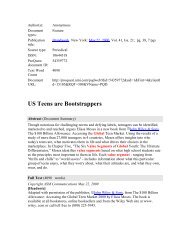

![Graduate Bulletin [PDF] - MFC home page - Appalachian State ...](https://img.yumpu.com/50706615/1/190x245/graduate-bulletin-pdf-mfc-home-page-appalachian-state-.jpg?quality=85)
